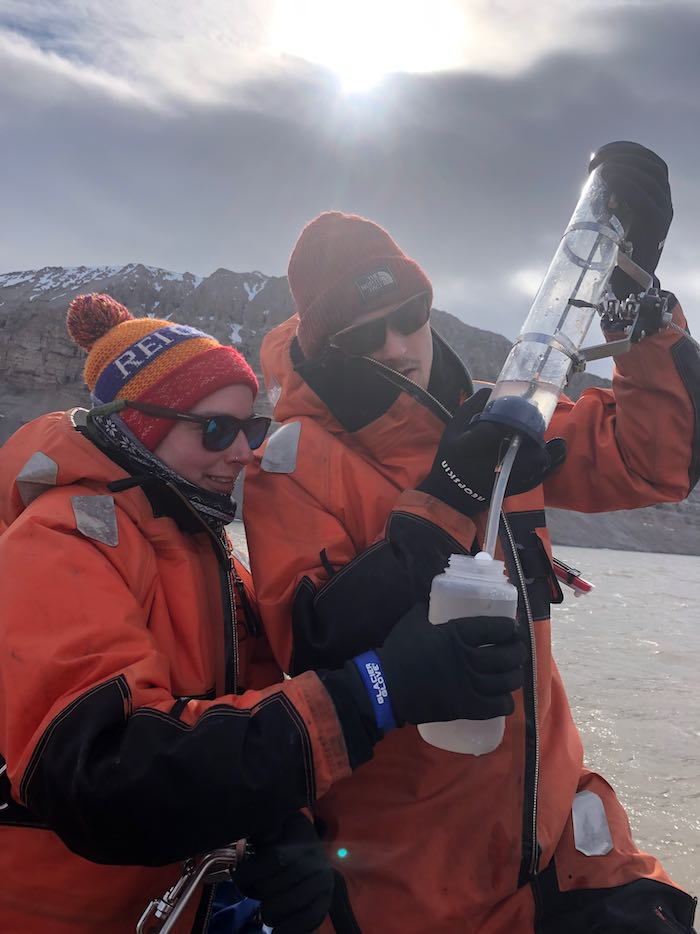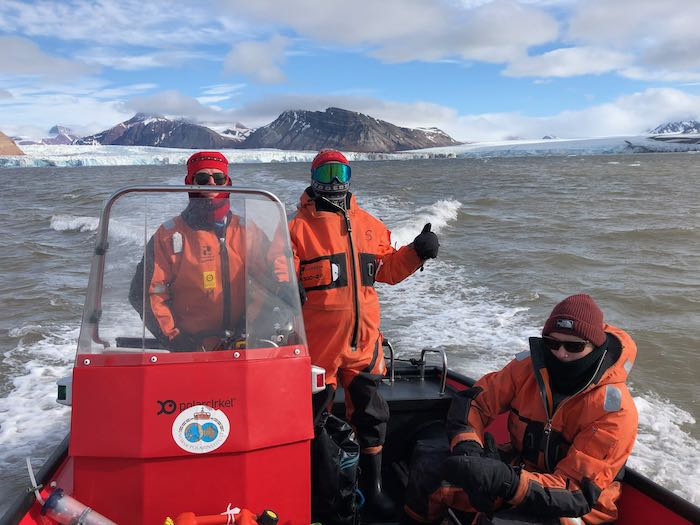A windy but successful start
Today we had a full day out on the fjord. Our main objective was to test out the CTD, water sampler and velocity meter. I also got a chance to do more drone flying.
As we drove the boat out towards the glacier face the wind really picked up and the waves seemed too rough to do data collection. But we found a protected bay on the North side of the glacier where the wind was light, and we were able to do our first CTD casts and water sampling.
 Xander and Kelly emptying a water sample.
Xander and Kelly emptying a water sample.
 Xander gives a thumbs up after the first water sampling.
Xander gives a thumbs up after the first water sampling.
I took this short video of Xander and me doing a CTD cast so you can see how the process works. The CTD device automatically collects data once you turn it on, and it detects the depth using a pressure sensor.
As we started to head home, we realized that the wind had died down in front of the main part of the glacier, so we headed over there to take more CTD casts and water sampling. Xander and Kelly also tested out the velocity meter. Unfortunately it seems that the drift of the boat will interfere with the ability to get reliable measurements, so we will be looking into another method to measure water velocity. (Stay tuned for the very old-fashioned method we may use to find the water velocity.)
 Kelly and Xander testing out the velocity meter.
Kelly and Xander testing out the velocity meter.
The data is beginning to tell a story
When we got back, Xander was able to download the data and begin processing it. Check out the graph that he created.
 Graph of one of our first CTD casts.
Graph of one of our first CTD casts.
This one graph already tells an interesting story. The y-axis (vertical) is depth from the surface (zero) down to 50 meters. There are 3 different things being graphed on the X-axis. The Green lines show Temperature, the Blue lines are Turbidity (how cloudy the water is) and the Brown lines show salinity (how salty the water is). There are two lines because the CTD device collects data on the way down and again on the way back up.
Notice on the graph how the salinity is low at the very top, and then it shoots up and stays at a steady value all the way down to 50 meters. Then, the water is super cloudy all the way down to about 7-8 meters. Also notice that the temperature gets a bit higher between about 10-40 meters and then it gets very cold at the bottom. This data was collected at the outside edge of an upwelling plume - where water exiting the glacier comes out into the ocean.
I won’t explain this little bit of data right away. Here’s a little puzzle for you - especially if you’re one of my students. What ideas do you have about why the water would be more cloudy and less salty at the top than at the bottom? And why do you think the temperature might rise a bit in the middle, and then get very cold at the bottom?
More drone footage
The conditions had calmed down so much that I was able to do some drone flying. I was able to practice flying alongside and over the glacier, and I even caught some calving events.
Check out this video I took from today’s drone flight. I think you’ll agree that the scenery is spectacular, and that we are incredibly lucky to get the chance to be here! From the footage we were able to see that we should be able to use the video to help characterize what is happening to the subglacial jets as they exit the glacier. Notice how brown the water is! This is evidence of the amazing amount of sediment carried by the glacier.
Flying the drone from a moving boat is a bit more of a challenge than I expected, especially landing the drone. Since you are on a moving base, you can’t just have the drone fly back to its starting point. And the drone has several anti-collision detectors that it takes a bit of practice to catch it. Xander has become quite adept at catching my drone.
 Here I am using my ipad to fly the drone.
Here I am using my ipad to fly the drone.
 Xander expertly plucks the drone from the air.
Xander expertly plucks the drone from the air.
Heading home
On our way home, we took a little tour of a very heavily sediment-laden iceberg. Here’s a little video I took. This iceberg came from the bottom of the iceberg, and you can see the huge amount of sediment it is carrying.
 Driving home after a successful day of data collection.
Driving home after a successful day of data collection.
 After we got back, we needed to spray off the survival suits since we got quite a bit of saltwater spray on our trip today!
After we got back, we needed to spray off the survival suits since we got quite a bit of saltwater spray on our trip today!

Comments
Add new comment